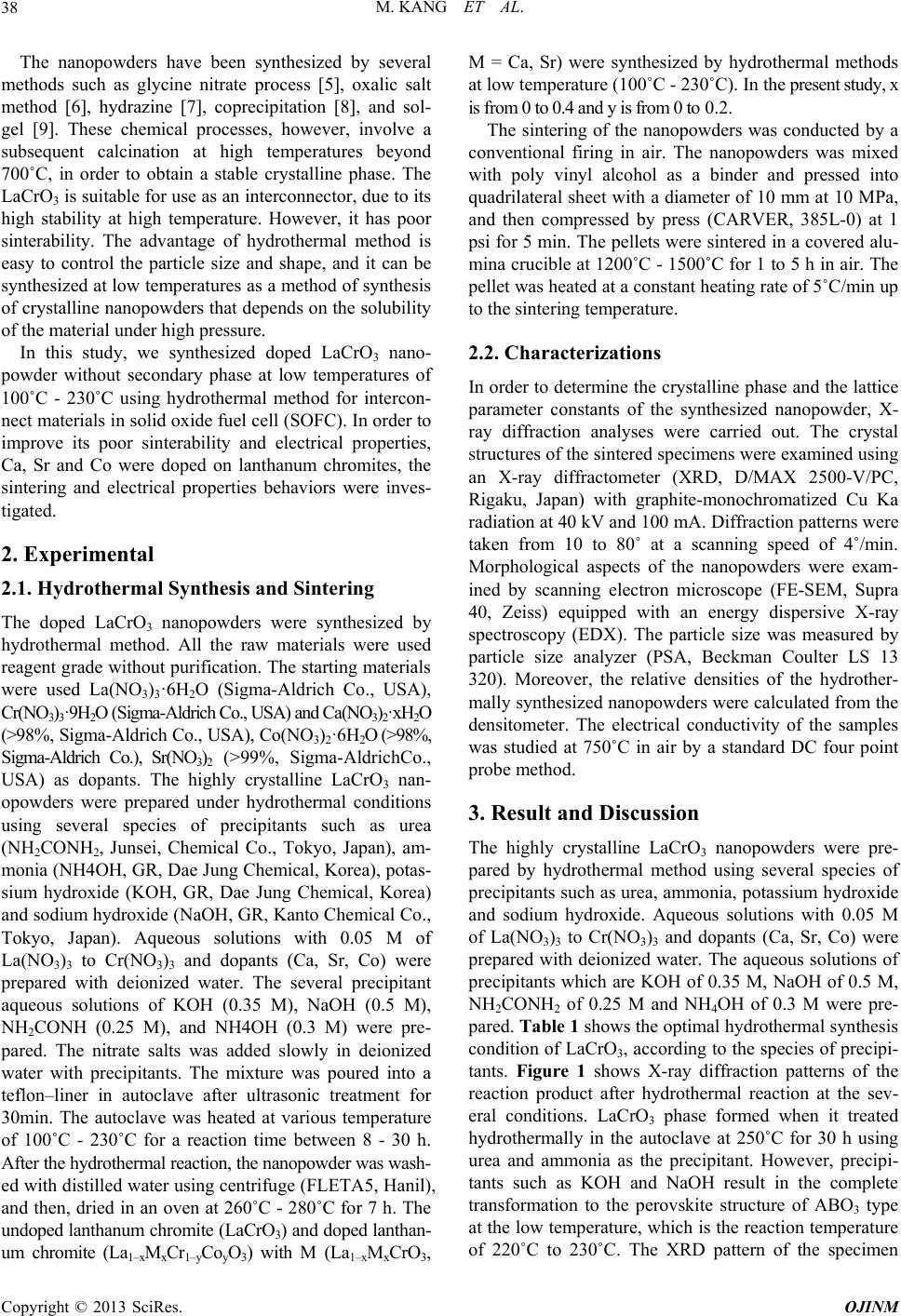
M. KANG ET AL.
38
The nanopowders have been synthesized by several
methods such as glycine nitrate process [5], oxalic salt
method [6], hydrazine [7], coprecipitation [8], and sol-
gel [9]. These chemical processes, however, involve a
subsequent calcination at high temperatures beyond
700˚C, in order to obtain a stable crystalline phase. The
LaCrO3 is suitable for use as an interconnector, due to its
high stability at high temperature. However, it has poor
sinterability. The advantage of hydrothermal method is
easy to control the particle size and shape, and it can be
synthesized at low temperatures as a method of synthesis
of crystalline nanopowders that depends on the solubility
of the material under high pressure.
In this study, we synthesized doped LaCrO3 nano-
powder without secondary phase at low temperatures of
100˚C - 230˚C using hydrothermal method for intercon-
nect materials in solid oxide fuel cell (SOFC). In order to
improve its poor sinterability and electrical properties,
Ca, Sr and Co were doped on lanthanum chromites, the
sintering and electrical properties behaviors were inves-
tigated.
2. Experimental
2.1. Hydrothermal Synthesis and Sintering
The doped LaCrO3 nanopowders were synthesized by
hydrothermal method. All the raw materials were used
reagent grade without purification. The starting materials
were used La(NO3)3·6H2O (Sigma-Aldrich Co., USA),
Cr(NO3)3·9H2O (Sigma-Aldrich Co., USA) and Ca(NO3)2·xH2O
(>98%, Sigma-Aldrich Co., USA), Co(NO3)2·6H2O (>98%,
Sigma-Aldrich Co.), Sr(NO3)2 (>99%, Sigma-AldrichCo.,
USA) as dopants. The highly crystalline LaCrO3 nan-
opowders were prepared under hydrothermal conditions
using several species of precipitants such as urea
(NH2CONH2, Junsei, Chemical Co., Tokyo, Japan), am-
monia (NH4OH, GR, Dae Jung Chemical, Korea), potas-
sium hydroxide (KOH, GR, Dae Jung Chemical, Korea)
and sodium hydroxide (NaOH, GR, Kanto Chemical Co.,
Tokyo, Japan). Aqueous solutions with 0.05 M of
La(NO3)3 to Cr(NO3)3 and dopants (Ca, Sr, Co) were
prepared with deionized water. The several precipitant
aqueous solutions of KOH (0.35 M), NaOH (0.5 M),
NH2CONH (0.25 M), and NH4OH (0.3 M) were pre-
pared. The nitrate salts was added slowly in deionized
water with precipitants. The mixture was poured into a
teflon–liner in autoclave after ultrasonic treatment for
30min. The autoclave was heated at various temperature
of 100˚C - 230˚C for a reaction time between 8 - 30 h.
After the hydrothermal reaction, the nanopowder was wash-
ed with distilled water using centrifuge (FLETA5, Hanil),
and then, dried in an oven at 260˚C - 280˚C for 7 h. The
undoped lanthanum chromite (LaCrO3) and doped lanthan-
um chromite (La1–xMxCr1–yCoyO3) with M (La1–xMxCrO3,
M = Ca, Sr) were synthesized by hydrothermal methods
at low temperature (100˚C - 230˚C). In the present study, x
is from 0 to 0.4 and y is from 0 to 0.2.
The sintering of the nanopowders was conducted by a
conventional firing in air. The nanopowders was mixed
with poly vinyl alcohol as a binder and pressed into
quadrilateral sheet with a diameter of 10 mm at 10 MPa,
and then compressed by press (CARVER, 385L-0) at 1
psi for 5 min. The pellets were sintered in a covered alu-
mina crucible at 1200˚C - 1500˚C for 1 to 5 h in air. The
pellet was heated at a constant heating rate of 5˚C/min up
to the sintering temperature.
2.2. Characterizations
In order to determine the crystalline phase and the lattice
parameter constants of the synthesized nanopowder, X-
ray diffraction analyses were carried out. The crystal
structures of the sintered specimens were examined using
an X-ray diffractometer (XRD, D/MAX 2500-V/PC,
Rigaku, Japan) with graphite-monochromatized Cu Ka
radiation at 40 kV and 100 mA. Diffraction patterns were
taken from 10 to 80˚ at a scanning speed of 4˚/min.
Morphological aspects of the nanopowders were exam-
ined by scanning electron microscope (FE-SEM, Supra
40, Zeiss) equipped with an energy dispersive X-ray
spectroscopy (EDX). The particle size was measured by
particle size analyzer (PSA, Beckman Coulter LS 13
320). Moreover, the relative densities of the hydrother-
mally synthesized nanopowders were calculated from the
densitometer. The electrical conductivity of the samples
was studied at 750˚C in air by a standard DC four point
probe method.
3. Result and Discussion
The highly crystalline LaCrO3 nanopowders were pre-
pared by hydrothermal method using several species of
precipitants such as urea, ammonia, potassium hydroxide
and sodium hydroxide. Aqueous solutions with 0.05 M
of La(NO3)3 to Cr(NO3)3 and dopants (Ca, Sr, Co) were
prepared with deionized water. The aqueous solutions of
precipitants which are KOH of 0.35 M, NaOH of 0.5 M,
NH2CONH2 of 0.25 M and NH4OH of 0.3 M were pre-
pared. Table 1 shows the optimal hydrothermal synthesis
condition of LaCrO3, according to the species of precipi-
tants. Figure 1 shows X-ray diffraction patterns of the
reaction product after hydrothermal reaction at the sev-
eral conditions. LaCrO3 phase formed when it treated
hydrothermally in the autoclave at 250˚C for 30 h using
urea and ammonia as the precipitant. However, precipi-
tants such as KOH and NaOH result in the complete
transformation to the perovskite structure of ABO3 type
at the low temperature, which is the reaction temperature
of 220˚C to 230˚C. The XRD pattern of the specimen
Copyright © 2013 SciRes. OJINM